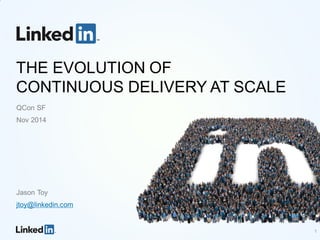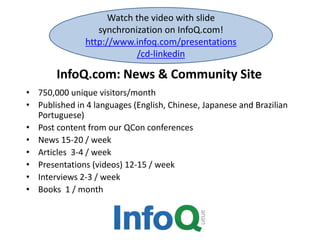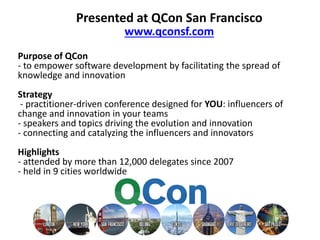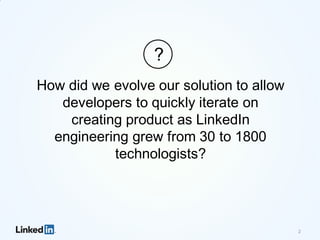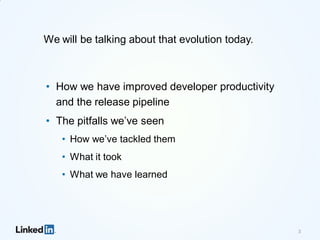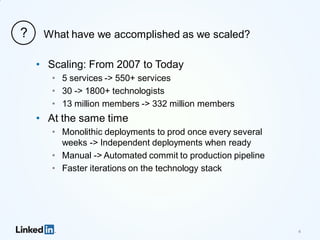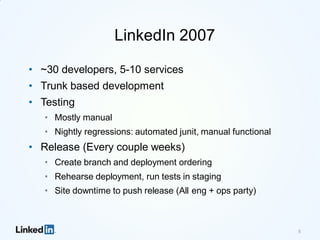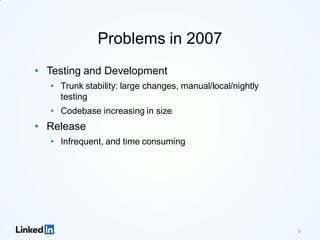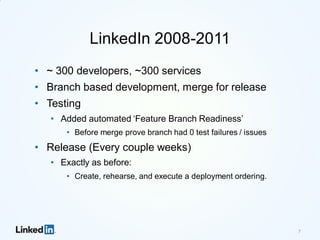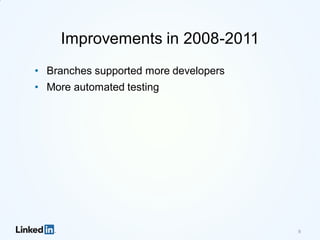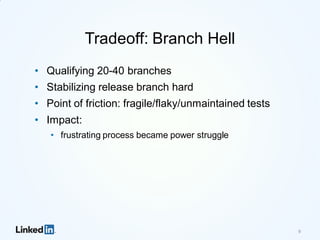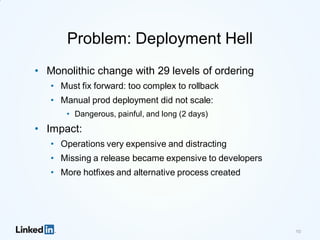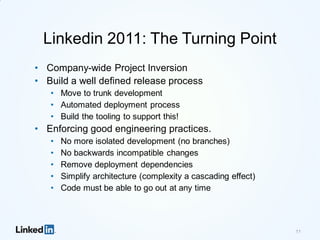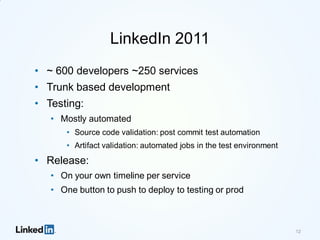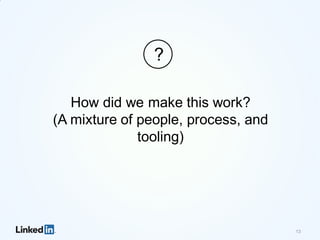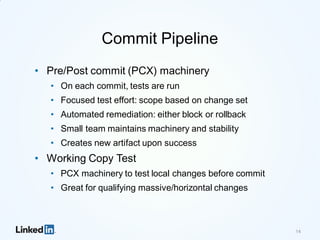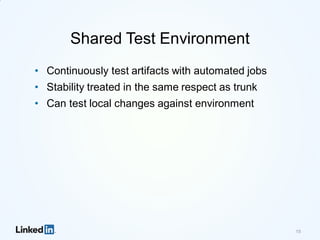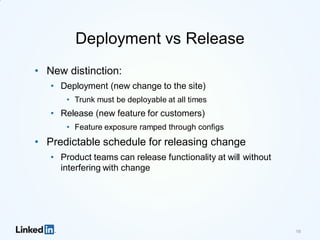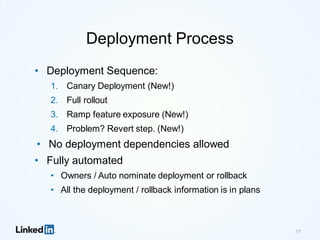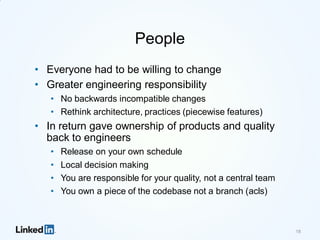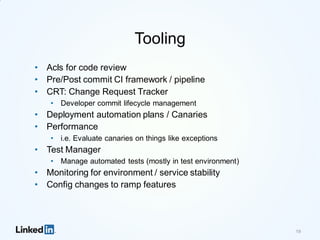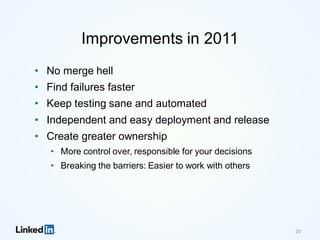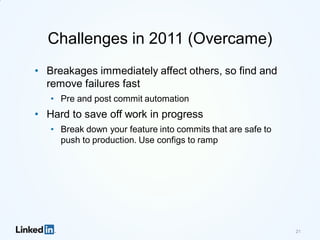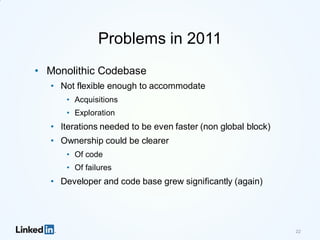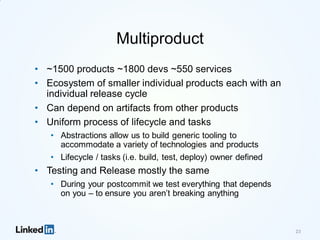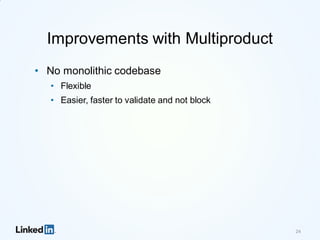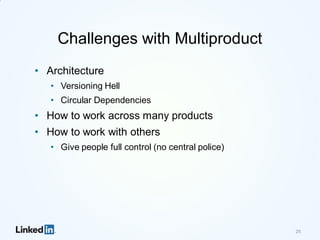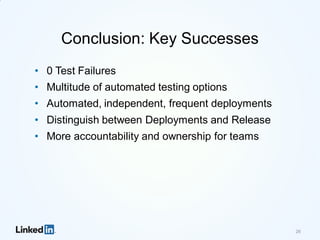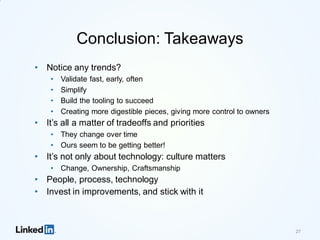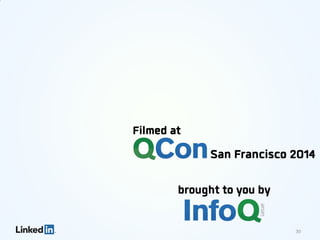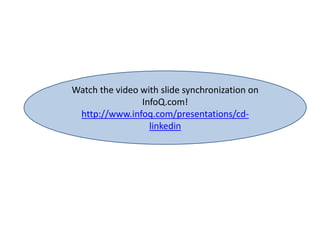The Evolution of Continuous Delivery at Scale @ Linkedin
- 1. THE EVOLUTION OF CONTINUOUS DELIVERY AT SCALE QCon SF Nov 2014 Jason Toy [email protected] 1
- 2. InfoQ.com: News & Community Site • 750,000 unique visitors/month • Published in 4 languages (English, Chinese, Japanese and Brazilian Portuguese) • Post content from our QCon conferences • News 15-20 / week • Articles 3-4 / week • Presentations (videos) 12-15 / week • Interviews 2-3 / week • Books 1 / month Watch the video with slide synchronization on InfoQ.com! http://www.infoq.com/presentations /cd-linkedin
- 3. Purpose of QCon - to empower software development by facilitating the spread of knowledge and innovation Strategy - practitioner-driven conference designed for YOU: influencers of change and innovation in your teams - speakers and topics driving the evolution and innovation - connecting and catalyzing the influencers and innovators Highlights - attended by more than 12,000 delegates since 2007 - held in 9 cities worldwide Presented at QCon San Francisco www.qconsf.com
- 4. How did we evolve our solution to allow developers to quickly iterate on creating product as LinkedIn engineering grew from 30 to 1800 technologists? 2 ?
- 5. We will be talking about that evolution today. 3 • How we have improved developer productivity and the release pipeline • The pitfalls we’ve seen • How we’ve tackled them • What it took • What we have learned
- 6. 4 What have we accomplished as we scaled?? • Scaling: From 2007 to Today • 5 services -> 550+ services • 30 -> 1800+ technologists • 13 million members -> 332 million members • At the same time • Monolithic deployments to prod once every several weeks -> Independent deployments when ready • Manual -> Automated commit to production pipeline • Faster iterations on the technology stack
- 7. 5 LinkedIn 2007 • ~30 developers, 5-10 services • Trunk based development • Testing • Mostly manual • Nightly regressions: automated junit, manual functional • Release (Every couple weeks) • Create branch and deployment ordering • Rehearse deployment, run tests in staging • Site downtime to push release (All eng + ops party)
- 8. Problems in 2007 • Testing and Development • Trunk stability: large changes, manual/local/nightly testing • Codebase increasing in size • Release • Infrequent, and time consuming 6
- 9. LinkedIn 2008-2011 • ~ 300 developers, ~300 services • Branch based development, merge for release • Testing • Added automated ‘Feature Branch Readiness’ • Before merge prove branch had 0 test failures / issues • Release (Every couple weeks) • Exactly as before: • Create, rehearse, and execute a deployment ordering. 7
- 10. Improvements in 2008-2011 • Branches supported more developers • More automated testing 8
- 11. Tradeoff: Branch Hell • Qualifying 20-40 branches • Stabilizing release branch hard • Point of friction: fragile/flaky/unmaintained tests • Impact: • frustrating process became power struggle 9
- 12. Problem: Deployment Hell • Monolithic change with 29 levels of ordering • Must fix forward: too complex to rollback • Manual prod deployment did not scale: • Dangerous, painful, and long (2 days) • Impact: • Operations very expensive and distracting • Missing a release became expensive to developers • More hotfixes and alternative process created 10
- 13. Linkedin 2011: The Turning Point • Company-wide Project Inversion • Build a well defined release process • Move to trunk development • Automated deployment process • Build the tooling to support this! • Enforcing good engineering practices. • No more isolated development (no branches) • No backwards incompatible changes • Remove deployment dependencies • Simplify architecture (complexity a cascading effect) • Code must be able to go out at any time 11
- 14. LinkedIn 2011 • ~ 600 developers ~250 services • Trunk based development • Testing: • Mostly automated • Source code validation: post commit test automation • Artifact validation: automated jobs in the test environment • Release: • On your own timeline per service • One button to push to deploy to testing or prod 12
- 15. How did we make this work? (A mixture of people, process, and tooling) 13 ?
- 16. Commit Pipeline • Pre/Post commit (PCX) machinery • On each commit, tests are run • Focused test effort: scope based on change set • Automated remediation: either block or rollback • Small team maintains machinery and stability • Creates new artifact upon success • Working Copy Test • PCX machinery to test local changes before commit • Great for qualifying massive/horizontal changes 14
- 17. Shared Test Environment • Continuously test artifacts with automated jobs • Stability treated in the same respect as trunk • Can test local changes against environment 15
- 18. Deployment vs Release • New distinction: • Deployment (new change to the site) • Trunk must be deployable at all times • Release (new feature for customers) • Feature exposure ramped through configs • Predictable schedule for releasing change • Product teams can release functionality at will without interfering with change 16
- 19. Deployment Process • Deployment Sequence: 1. Canary Deployment (New!) 2. Full rollout 3. Ramp feature exposure (New!) 4. Problem? Revert step. (New!) • No deployment dependencies allowed • Fully automated • Owners / Auto nominate deployment or rollback • All the deployment / rollback information is in plans 17
- 20. People • Everyone had to be willing to change • Greater engineering responsibility • No backwards incompatible changes • Rethink architecture, practices (piecewise features) • In return gave ownership of products and quality back to engineers • Release on your own schedule • Local decision making • You are responsible for your quality, not a central team • You own a piece of the codebase not a branch (acls) 18
- 21. Tooling • Acls for code review • Pre/Post commit CI framework / pipeline • CRT: Change Request Tracker • Developer commit lifecycle management • Deployment automation plans / Canaries • Performance • i.e. Evaluate canaries on things like exceptions • Test Manager • Manage automated tests (mostly in test environment) • Monitoring for environment / service stability • Config changes to ramp features 19
- 22. Improvements in 2011 • No merge hell • Find failures faster • Keep testing sane and automated • Independent and easy deployment and release • Create greater ownership • More control over, responsible for your decisions • Breaking the barriers: Easier to work with others 20
- 23. Challenges in 2011 (Overcame) • Breakages immediately affect others, so find and remove failures fast • Pre and post commit automation • Hard to save off work in progress • Break down your feature into commits that are safe to push to production. Use configs to ramp 21
- 24. Problems in 2011 • Monolithic Codebase • Not flexible enough to accommodate • Acquisitions • Exploration • Iterations needed to be even faster (non global block) • Ownership could be clearer • Of code • Of failures • Developer and code base grew significantly (again) 22
- 25. Multiproduct • ~1500 products ~1800 devs ~550 services • Ecosystem of smaller individual products each with an individual release cycle • Can depend on artifacts from other products • Uniform process of lifecycle and tasks • Abstractions allow us to build generic tooling to accommodate a variety of technologies and products • Lifecycle / tasks (i.e. build, test, deploy) owner defined • Testing and Release mostly the same • During your postcommit we test everything that depends on you – to ensure you aren’t breaking anything 23
- 26. Improvements with Multiproduct • No monolithic codebase • Flexible • Easier, faster to validate and not block 24
- 27. Challenges with Multiproduct • Architecture • Versioning Hell • Circular Dependencies • How to work across many products • How to work with others • Give people full control (no central police) 25
- 28. Conclusion: Key Successes • 0 Test Failures • Multitude of automated testing options • Automated, independent, frequent deployments • Distinguish between Deployments and Release • More accountability and ownership for teams 26
- 29. Conclusion: Takeaways • Notice any trends? • Validate fast, early, often • Simplify • Build the tooling to succeed • Creating more digestible pieces, giving more control to owners • It’s all a matter of tradeoffs and priorities • They change over time • Ours seem to be getting better! • It’s not only about technology: culture matters • Change, Ownership, Craftsmanship • People, process, technology • Invest in improvements, and stick with it 27
- 30. Thanks! 28
- 31. Questions? 29
- 32. 30
- 33. Watch the video with slide synchronization on InfoQ.com! http://www.infoq.com/presentations/cd- linkedin

